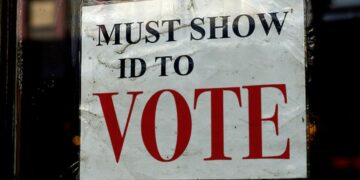A new study from the Wisconsin Institute of Law and Liberty challenges the claim that voter ID laws suppress voter turnout, particularly among historically disadvantaged groups. As Wisconsin voters prepare to decide on a constitutional amendment enshrining voter ID requirements on April 1st, this research provides crucial insights into the real impact of these laws. Here is what the study shows:
- No Evidence of Turnout Suppression
The study finds no statistically significant negative impact of Wisconsin’s voter ID law on overall voter turnout. In fact, turnout has slightly increased since the law’s implementation, challenging claims that voter ID requirements lead to widespread disenfranchisement.
- No Negative Effect on Minority Voters
There is no evidence of a negative effect on turnout from the implementation of voter ID among non-white Wisconsinites.
- No Negative Effect in Milwaukee and Dane Counties
When analyzing these counties in isolation, no correlation was found between voter ID laws and changes in voter turnout over time.
- External Factors Influence Turnout More Significantly
Socioeconomic factors—such as poverty rates and education levels—have a stronger correlation with voter turnout than voter ID laws. The study found that higher poverty rates and lower education levels were associated with lower participation, independent of voter ID requirements.
- Policy Implications
The findings do not support the conclusion that voter ID laws are restricting the right to vote. This directly undercuts the argument that constitutionalizing voter ID in Wisconsin would lead to disenfranchisement.
Wisconsin’s Constitutional Amendment on the Ballot
As Wisconsin’s Spring Election approaches on April 1st, voters will have the opportunity to weigh in on a key constitutional amendment that would make photographic identification a permanent requirement for voting. This amendment, which has passed two consecutive legislative sessions, now moves to the final stage—public approval at the ballot box.
What’s on the Ballot?
Voters will see the following question:
“Shall section 1m of article III of the constitution be created to require that voters present valid photographic identification verifying their identity in order to vote in any election, subject to exceptions which may be established by law?”
- A YES vote supports adding this requirement to the state constitution.
- A NO vote opposes making voter ID a constitutional requirement.
Voters Overwhelmingly Support Voter ID
The latest Marquette Law School poll confirms that Wisconsin voters overwhelmingly support requiring photo identification at the ballot box, with 77% in favor and only 22% opposed. This aligns with over a decade of polling data showing strong and consistent public backing for voter ID laws, with support never dipping below 63% since 2012.
Susan Crawford vs. Brad Schimel on Voter ID
Despite this widespread approval, Supreme Court candidate Susan Crawford has relentlessly fought to overturn Wisconsin’s voter ID law, labeling it “draconian” and working to dismantle the requirement in court. While Crawford was successful in lower courts, ultimately, the Wisconsin Supreme Court ruled voter ID as constitutional.
Her opponent, Brad Schimel, has reminded voters he defended voter ID as Wisconsin’s Attorney General, reinforcing his commitment to election integrity.
How to Obtain a Voter ID
For those without a valid ID, Wisconsin provides free state-issued ID cards for voting. Even if you lack required documentation, you can complete additional paperwork at the DMV to receive an ID. If applying close to Election Day, the DMV will expedite the process to ensure you can vote.
Where to Learn More
Voters looking for more information on what’s on their ballot can visit myvote.wi.gov or call the Voter ID Hotline at (844) 588-1069.





























